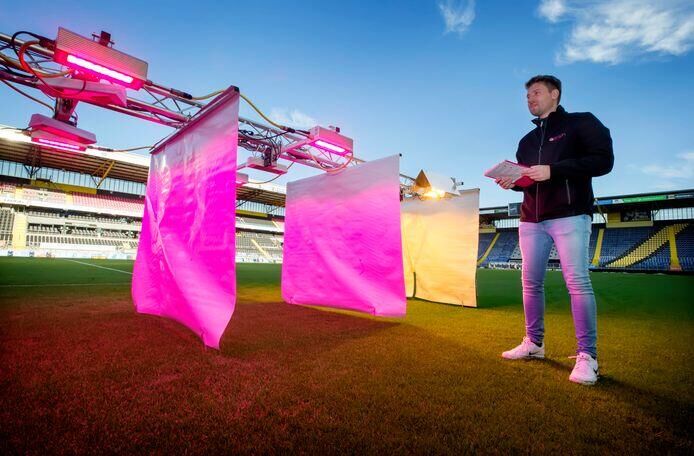News
Oreon investigates added value of LED for grass in football stadiums
In late October, Oreon installed a new lighting cart with LED fixtures in the Rat Verlegh Stadium in Breda, The Netherlands. We will be investigating whether LED has added value for grass in football (soccer) stadiums.
The aim is to ascertain in a scientific way whether grass becomes stronger and grows more quickly if the lighting cart is fitted with cooled LED fixtures. The cart will stand on an 8 square meter (approx. 86 square foot) area of grass until December. It will then be moved to another area of the field to see whether the same thing happens there and to rule out any substantial differences.
The cart is being used on the part of the field that is almost permanently in the shade, in the corner between section G and the official grandstand, along the 16 meter line. The lighting cart consists of three configurations:
- Configuration 1: a conventional HPS lamp of the type normally used in football stadiums;
- Configuration 2: a water-cooled LED lamp set to the same temperature as the HPS lamp. This will enable us to identify any difference between HPS and LED light in general;
- Configuration 3: a water-cooled LED lamp providing a constant grass temperature that allows the grass to grow at the same temperature all year round.
Our expectation is that the third configuration will produce the best grass results.
NAC sponsor Oreon also carried out some tests on the football club's field last year. These showed that the roots of the grass grew significantly longer and stronger. Instead of the usual five centimeters (two inches) or more, the roots were now growing up to as much as nine centimeters (3½ inches) deep, meaning that the grass was becoming significantly stronger. We now want to demonstrate this more specifically. Up to now, football clubs have used HPS lighting to prepare the field for play every two weeks. However, we suspect that LED will actually work much better. With HPS, it is difficult to control the temperature of the radiated heat, for example. They also use much more energy.
Investigating this in a real stadium setting is an important step. NAC generally plays on this field every two weeks, so the field naturally gets damaged – with all those duels, sliding tackles, and so on. And when you add the weather conditions into the mix, preparing the field for play every two weeks is a challenge. In addition, a stadium creates varying amounts of shade; the part of the field where we are carrying out this research almost never sees the sun, and yet grass needs light to survive. The wind also plays a completely different role in a stadium than on an open field.
This research is being carried out in collaboration with the HAS University of Applied Sciences and NAC’s grass experts Hubra Fieldmanagement.
Click here to read the newspaper article of BNdeStem from October, 26. (only available in Dutch)
Photo: © Pix4Profs/Joyce van Belkom
